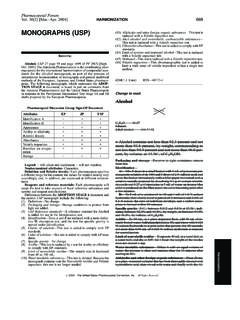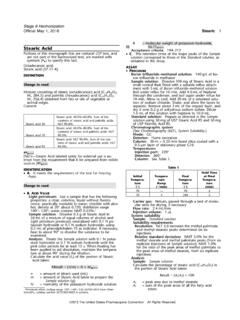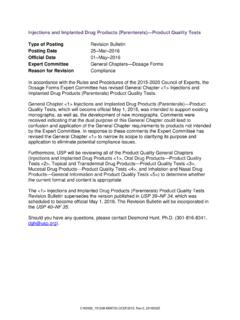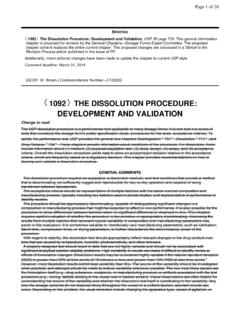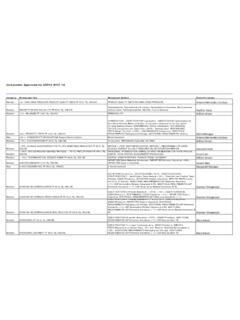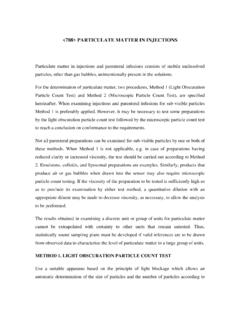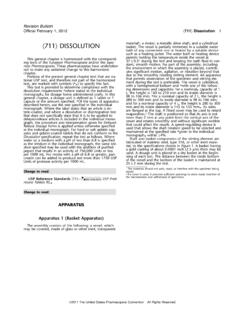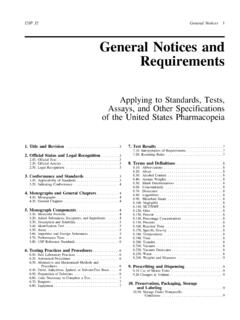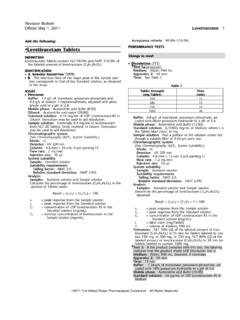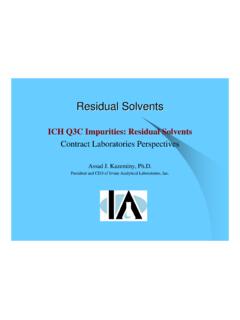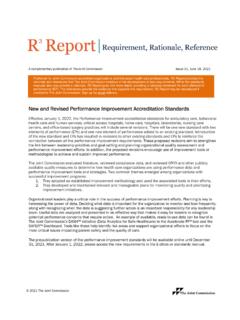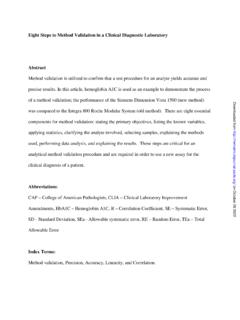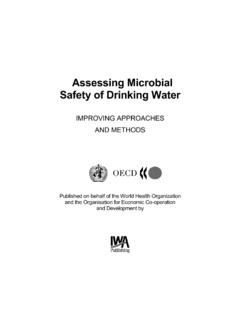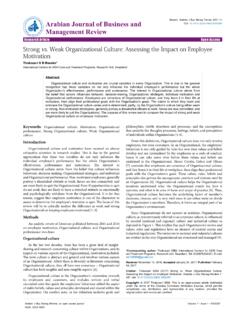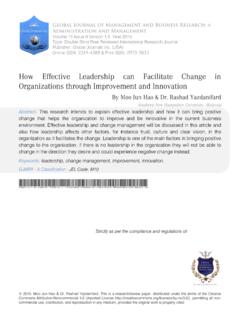Transcription of Lifecycle Management of Analytical Procedures: Method ...
1 STIMULI TO THE REVISION PROCESS Stimuli articles do not necessarily reflect the policies of the USPC or the USP Council of Experts Lifecycle Management of Analytical Procedures: Method Development, Procedure performance Qualification, and Procedure performance Verificationa USP Validation and Verification Expert Panel: Gregory P Martin, MS (Chair); Kimber L Barnett, PhD; Christopher Burgess, PhD; Paul D Curry, PhD; Joachim Ermer, PhD; Gyongyi S Gratzl, PhD; John P Hammond; Joerg Herrmann, PhD; Elisabeth Kovacs; David J LeBlond, PhD; Rosario LoBrutto, PhD; Anne K McCasland-Keller, PhD; Pauline L McGregor, PhD; Phil Nethercote, PhD; Allen C Templeton, PhD; David P Thomas, PhD; ML Jane Weitzel ABSTRACT In this Stimuli article, the USP Validation and Verification Expert Panel discusses how the modern concept of a Lifecycle model, which is based on process validation and described in ICH guidelines Q8, Q9, and Q10, can be applied to Analytical procedures.
2 The Expert Panel proposes that the traditional approaches to validation, transfer, and verification should be integrated into the Analytical procedure Lifecycle process rather than being viewed as separate entities. As a starting point or predefined objective according to ICH Q8, the requirements for a measurement of a critical quality attribute are established in the Analytical Target Profile. In alignment with process validation, three stages are proposed: Procedure Design (development and understanding), Procedure performance Qualification, and Continued Procedure performance Verification. INTRODUCTION Any Analytical procedure must be shown to be fit for its intended purpose before use. [NOTE The term Analytical procedure used in this Stimuli article is interchangeable with the term Method commonly used in industry and includes steps such as sample preparation, Analytical technique, calibration, and definition of the reportable result.]
3 ] The usual process of demonstrating this suitability in food and drug Analytical laboratories takes place by way of a documented validation study and, if required, a verification or transfer process to demonstrate the procedure performs appropriately in the laboratory in which it will be used. The United States Pharmacopeial Convention (USP) has been a strong advocate of this process. General chapter Validation of Compendial Procedures 1225, which was first published in USP XXI (1989), served as the foundation for the development of the ICH Q2 Guidance on Validation of Analytical Procedures (1). More recently, USP has further led on this topic with the publication of general chapters Verification of Compendial Procedures 1226 and Transfer of Analytical Procedures 1224 (Figure 1).
4 Figure 1. Current typical process for Analytical procedures. The intent of ICH Q2 and 1225 was to provide guidance to the industry about how to validate different types of Analytical procedures. This guidance was intended to be used in combination with sound scientific judgment to ensure that appropriate experiments applicable to different Analytical procedures and situations would be performed on a case-by-case basis. Over time, however, these documents have come to be interpreted as mandatory expectations rather than scientific guidance. Although these practices are successful in many cases, there are opportunities to further refine and improve them. The ICH and USP documents provide guidance pertaining to procedure suitability as part of the procedure validation exercise ( , accuracy, precision, linearity, specificity, etc.)
5 , but they do not provide a framework that allows users to reliably understand and control sources of variability. Similar observations were made in the manufacturing process development area, leading to development of the Lifecycle Management process described in ICH Q8, Q9, and Q10 (and more recently Q11) (2 5). Taking these ICH documents into consideration, the USP Validation and Verification Expert Panel has reevaluated the current validation, verification, and transfer guidelines for Analytical procedures. The Lifecycle concept described in ICH Q8 is adaptable to Analytical procedures if we consider an Analytical procedure as a process and the output of this process as the reportable result, that is, the value that will be compared to the acceptance criterion. The purpose of applying Lifecycle principles to Analytical procedures is to holistically align Analytical procedure variability with the requirements of the product to be tested and to improve the reliability of the procedure by understanding, reducing, and controlling sources of variability.
6 Enhanced understanding of variables that affect the performance of an Analytical procedure provides greater assurance that the quality attributes of the tested product can be reliably assessed. The Lifecycle Management process provides a framework for defining the criteria for and development of an Analytical procedure that meets the acceptance criteria. The procedure then becomes part of a continuous verification cycle to demonstrate that it meets the predefined criteria over the life of the procedure. Implementation throughout the procedure's Lifecycle of a change Management process that is based on knowledge gained during the procedure's lifetime ensures that the procedure remains fit for its intended use. Key to the general approach is an understanding of overall variability, including variability arising from the manufacturing process as well as the Analytical procedure.
7 A focus of USP has been understanding the variability of its reference materials, which are part of the total variability that should be understood, controlled and, where possible, reduced. In this Stimuli article, the USP Validation and Verification Expert Panel discusses how the modern concept for process validation (6,7), which is based on a Lifecycle model, can be applied to Analytical procedures (8 11). We propose that the traditional approaches to validation, transfer, and verification should be integrated into the Analytical procedure Lifecycle process rather than being viewed as separate entities. The Validation and Verification Expert Panel proposes that the concepts addressed in 1225, 1226, and 1224 should be revised and compiled into a single new general information chapter, Lifecycle Management of Analytical Procedures 1220 and a new general chapter 220 specifying the basic requirements.
8 The Validation and Verification Expert Panel seeks reader comments on the contents of this Stimuli article. THE Lifecycle APPROACH Results generated using Analytical procedures provide the basis for key decisions regarding compliance with regulatory, compendial, and manufacturing limits. The results are applied against Decision Rules that give a prescription for the acceptance or rejection of a product based on the measurement result, its uncertainty, and acceptance criteria, taking into account the acceptable level of the probability of making a wrong decision (12,13). The adoption of a Lifecycle approach to ensure the quality of pharmaceutical products has been extensively discussed during the past several years (2 7). The concept of Quality by Design (QbD) is understood as a systematic approach that begins with predefined objectives and emphasizes product and process understanding and process control, based on sound science and quality risk Management (ICH Q8).
9 Application of Lifecycle Management concepts to Analytical procedures provides an opportunity to use the knowledge gained from the application of scientific approaches and quality risk Management to continual improvement and assurance of data quality. There should be an effective Quality Management System in place consistent with ICH Q10. The concepts described in ICH Q10 complement current GMPs, thus providing an integrated model for a pharmaceutical or similar quality system. This supports continual improvement across the entire Lifecycle of the Analytical procedure. The Analytical Target Profile (ATP), risk Management , control strategy, and knowledge Management are cornerstone concepts in Lifecycle Management , which will be discussed in the following sections. Analytical Target Profile A fundamental component of the Lifecycle approach to Analytical procedures is having a predefined objective that stipulates the performance requirements for the Analytical procedure.
10 These requirements are derived from the Analytical Target Profile (ATP). See Figure 2 for some examples. Figure 2. Examples of Potential Analytical Target Profiles. [NOTE Items in brackets and italics (variables listed as capital letters and numerical values) are placeholders to be replaced by specific items for an ATP.] The concept of an ATP parallels the concept of a Quality Target Product Profile described and defined in ICH Q8. The ATP defines the requirements for the product of the test procedure, which in this case is the reportable result. Criteria defined in the ATP refer to the quality data attributes of the reportable result, , accuracy and measurement uncertainty, which include all sources of variability, including precision. Identifying the output of the Analytical procedure as the reportable result provides a target for development and helps to ensure the procedure is developed toward predetermined performance requirements that are directly linked to the quality of the data.
